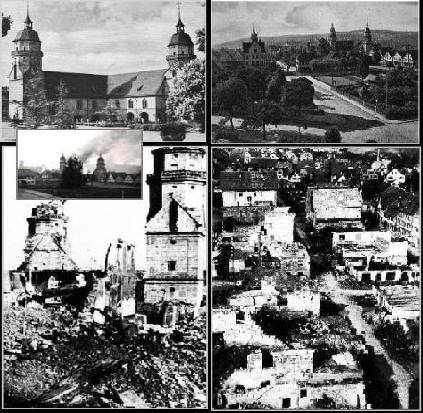

In 1599, the first exiles from Carinthia arrived in what was still wilderness and they had to first clear the forests and build the necessary infrastructure. Only a remote road leading toward Strasbourg was in place in the wild countryside.
The Duke hired Renaissance architect Heinrich Schick Hardt to design a town plan and he commanded him to build a castle “in the middle of the market” larger than the Stuttgart Castle. The foundation stone of a new church for the exiles was laid in 1601, but the Duke unfortunately died in 1608 before his dream was completed: he never saw his castle built. However, because it was planned to contain a castle, the market place in Freudenstädt was and still is the largest in Germany. The new residents initially lived in simple wooden huts, but by 1602, four sides of the market place were built with a total of 80 buildings completed. The population grew steadily and more and more refugees arrived. By 1603, 250 settlers had become 1,000 people and by 1609, 2,000.
Among the immigrants from Carinthia were some from Styria and also some Protestant Slavs. In 1628, after 300 Protestant nobles back home in Carinthia were expelled, the population grew even more. The Duke’s vision was realized after his death and Freudenstadt, built to give refuge to persecuted religious exiles, turned into a place of remarkable beauty.
Friedrich I, Duke of Württemberg, the son of Georg Mömpelgard, is alluded to in Shakespeare’s ‘The Merry Wives of Windsor.’ As heir apparent to the dukedom of Württemberg, Friedrich visited Windsor and other English cities in 1592, and he yearned to be made a Knight of the Garter and repeatedly solicited Queen Elizabeth for the honor. After he inherited the dukedom and became more prominent, she admitted him to the order, but intentionally did not inform him in time for him to attend the spring investiture in 1597, the ceremony for which ‘The Merry Wives of Windsor’ was written. Thus Shakespeare’s references to the one German duke who would not be present in Windsor were jokes, and they appeared in the First Folio edition of the play.
Napoleon took his armies through Württemberg on his way to attack the eastern countries and to Russia, and these marches ravaged and plundered Germany. The French troops demanded free quartering and food all along the way from peasants and dukes alike, resulting in severe food shortages. The smaller hamlets of the Württemberg area were also becoming over-populated, and the younger generation had no land of their own. Many people left the area at this time.
Some were invited to settle in the vast empire of Russia from about 1763 to 1862. German workers and traders were already living there, having settled in the 16th century at the invitation first of Ivan the Terrible (1553-1584), then by Peter the Great (1672-1725), who had invited Germans to Russia to help him “westernize” rural Russia, and then by Catharine the Great who enticed settlers to sparsely populated regions, especially in the Volga valley. Some Württembergers moved to the area of today’s Ukraine. Friedrich the Great of Prussia also offered Württembergers land in Prussian Poland if they would come teach the local people modern farming methods, especially in areas recently reclaimed by clearing brush and draining marshes. Even young America beckoned. By the year 1765, there were an estimated 7,500-8,000 Germans and German-Swiss who had come to the province of South Carolina, many Württembergers among them.

The barrage lasted into the following night, reducing the town to rubble and ash and unnecessarily destroying 95% of the core of the city. French soldiers of the third Moroccan Spahi regiment under the command of Major Christian de Castries went into the town with official permission to plunder, and this they did, for three days and three nights, even robbing the inhabitants in broad daylight.
Buildings which had been lucky enough to escape bomb destruction were set ablaze and the Germans were forbidden to extinguish the fires which were burning their homes and businesses. Surviving citizens of Freudenstädt who had taken refuge in their cellars were ferreted out of their shelters, thrown into the streets and robbed and shot. 500 women and girls were documented as having been raped. The carnage went on for days, leaving 1,400 families homeless. As in other bomb ravaged cities, there was great debate later as to whether to rebuild in modern or original form and a combination won out. After “re-education,” beleaguered Freudenstädt led the pack in the apologetic “reconciliation” movement and is now “twinned” to a French city.